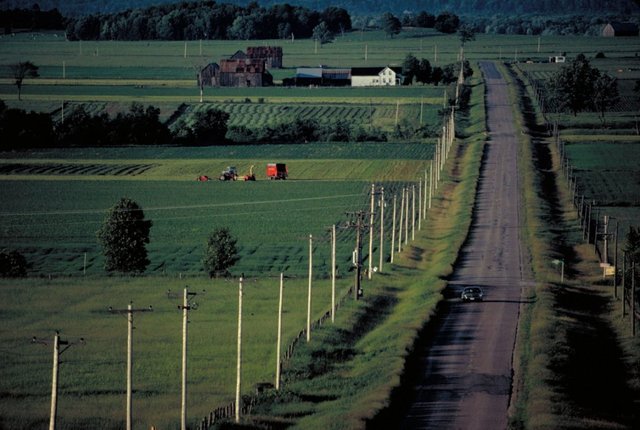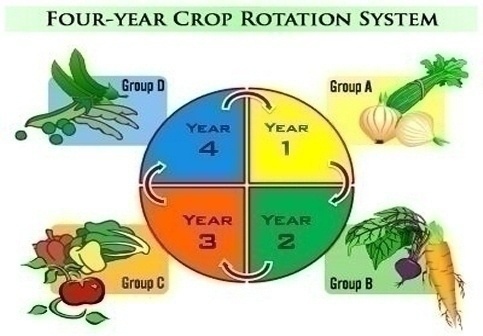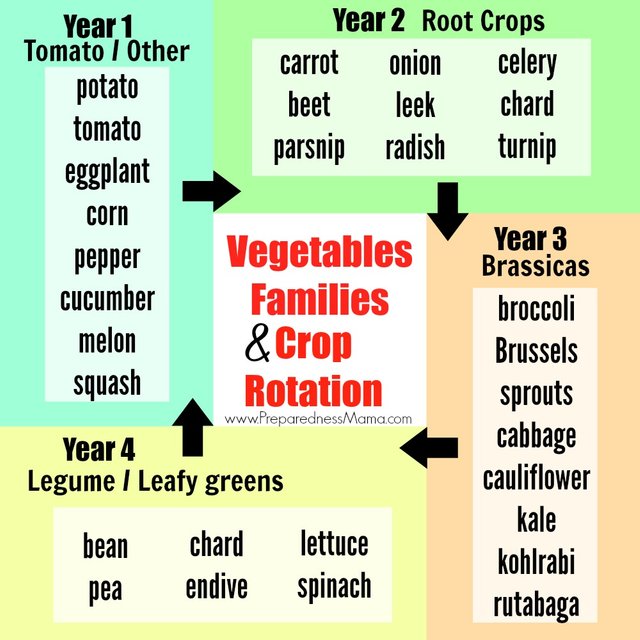The Importance of Crop Rotation
Living in a small community relatively a farming community, you see all kinds of unusual things. I was driving past a farm that I have driven past countless times over the years. Now this farm traditionally as far as I knew always grew corn, then yesterday, I had noticed he was growing something different, a grain of some sort. I thought that is strange. So because everybody know's everybody in a small town, I stopped my friend farmer Gerald and inquired as to why he changed his crop. He responded with, I am doing a crop rotation so that I don't have soil erosion. WHAT? So he continued to explain. This post will describe the concept and importance of crop rotation. Follow along to learn more.
This is a picture of one of the roads in my community, and farmer Gerald's farm is the last plot or field in the top of the picture.

First lets define Crop of Plant Rotation. Essentially it is a process that farmers and gardeners alike should not grow the same kind of crops in the same place every year.
"Farmers who practice long-term crop rotation can reduce soil erosion on their land. A study conducted in 1988 found 6 inches more topsoil on an organic farm than on an adjacent conventional farm in the Palouse region of Washington state.
The 7,700-acre organic farm had been managed without the use of commercial fertilizers and with limited use of approved pesticides since its soil was first plowed in 1909. Researchers compared the organic farm’s topsoil to that of a nearby conventional farm. The 1,400-acre conventional farm, first cultivated in 1908, began receiving recommended rates of commercial fertilizers in 1948 and pesticides in the early 1950s.
The difference in topsoil depth between the two farms was attributed to significantly greater erosion on the conventional farm between 1948 and 1985. Researchers attributed the difference in erosion rates to crop rotation because the organic farmer included green manure crops within the rotation plan while the conventional farmer did not." Source: Reganold et al, 1988

Many think that crop rotation is only a practice for large scale field farms, however this is not the case. I personally have 5 raised garden beds, that are large. I rotate my crop between the 5 of them. Some of the beds are in full sun and some are in part sun/part shade, which makes it harder to rotate. In the case where I cannot rotate in that bed the appropriate crop for the sun/shade, I will leave the bed fallow. Fallow is concept of leaving fields unplowed in rotation––when a field lies fallow, the soil regains nutrients that are sucked up by over-planting. I tend to rotate my crop every 2 years, with one 2 of my raised beds I rotate every 3 years.
I follow a chart similar to this one.

The thing I have learned doing this, is that some of my crops do amazing one year compared to other years, when rotated. Some crops are heavy feeders that deplete garden soils while other crops are light feeders and others even help to build soil health. Crop rotation is done to ensure that the pests which grow on a particular crop are reduced in number. Also, it ensures that particular plant diseases will also not develop as a result of poor vegetable plant crop rotation.
So there you have it folks, some of the reason's why we rotate our crops, and some suggested charts to use, for rotating your plants. Hope this was helpful. If you have suggestions in how you rotate your crops please do share and spread the knowledge.
Happy Trails
Image Sources:
https://www.vegetablegrowing.co.uk/start-vegetable-crop-rotation.html
http://preparednessmama.com/crop-rotation-by-vegetable-families/
https://cefs.ncsu.edu/resources/organicproductionguide/croprotationsfinaljan09.pdf
Interesting, informative article. It's rather interesting what's happening here in Australia. Your smaller farmer stopped doing heavy crop rotations in the 1940s and 1950s with the advent of a new consumer market for pesticides and fertilisers. But now, due to erosion and diminished crop yields, many are going back to the old traditional ways, including crop rotation. On the other hand, the larger industrialised corporate farming don't do crop rotation, they just use it and move on - squeeze out every ounce and then just leave it to become wasteland. Very sad.
Wow I was not aware of this. It is truly sad. Let's hope that the smaller farms can sustain the land for your future generations. Thanks
We rotate crops but are also now adopting No Till. It truly works to preserve the soil, although it can take some time to rebuild. A toast to those who work the land.
Good for you! No till is the Way to Go!!
I don't till either. I have had successful harvests every year. Thanks
I learned about crop rotation 2 years ago and since then I keep a "Homestead Binder" with a booklet in it that I sketch my garden out in every winter and plan where everything will go that way the following year I can look back and see where everything needs to be planted/rotated. Great post! Definitely resteeming!
Great Idea. I make it a project for my 12 year old, she takes her pencil crayons and draws and colors out where my potatoes are carrots, cucumbers etc.
great article for farmers .. very helpful tips.. even for small gardeners can learn a lot from your post thanks
Thank you
I planted 3 tomatoes I bought from a garden store planted them where I had cantaloupe last year. They are barely making it & no fruits formed. Planted a few seeds in my 2 foot deep raised beds and those tomatoes are flourishing even withcucumbers growing all over them. Lots of tomatoes. Both areas get lots of sun. The tomatoes doing well also have peanut plants all around them. Peanut plants are so much fun to grow.
Oh me Gosh, Peanut Plants you say? DO tell where about's are you located? I must know so that if your in the same country we need to talk. LOL Thanks
Shared it for others to learn and benefit from!
Thank you so much. Knowledge is garden power. LOL
We did crop rotation on the farm in the 50's, 60's and 70's. Both in our fields and gardens. I just thought it was a normal practice since all the farm families were doing it. So I just assumed everyone knew about it.
Most do, but for larger scale farms. I was trying to inform the smaller garden folks that it is a practice that I encourage. Good on you for doing this. Thanks
Definitely, plants have a symbiotic relationship with the soil. It's a give and take in many ways on a molecular level and close interest in PH Balance.
Thanks for posting :-)
It's hard enough to keep the PH balance in good soil, rotating can only help.
Great information here, thank you. For my raised garden I achieve some sort of 'crop rotation' by switching the direction of the tiny rows. I mostly plant the same veggies year after year and have had success so far.
That works. So wonderful to see so many embracing growing their own food. Thanks
Yessss!! What a KEY subject to bring attention to!! Not only does it help the soil, it keeps pests away naturally because the ones that were breeding to kill, say the corn, are not the same that will try and infest a root crop!
Also thanks for the info about leaving a bed fallow, I didn't consider that before!